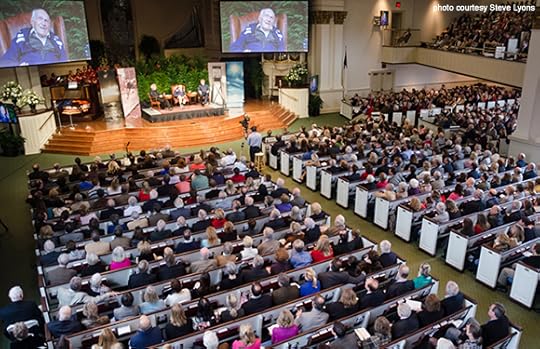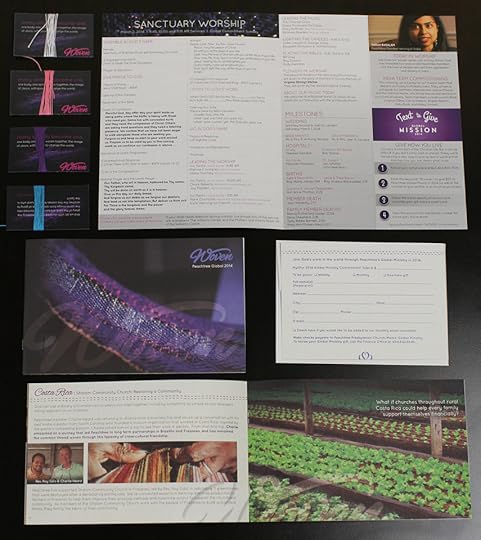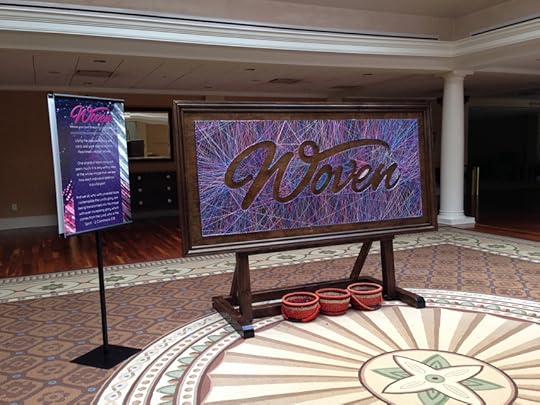Len Wilson's Blog, page 16
September 1, 2015
Think Like a Five Year Old Study Guide (Free eBook)
In many ways, 1964 was the cultural high water mark of the post-war era. After the destruction of the war era from 1914-1945, people wanted to explore, grow, and build new things. Of course, as George Clooney’s character Frank Walker said in the recent film Tomorrowland, “Then it all went to (you know where).”
Given our nature as humans, it always does. That’s the story of creativity. The key to reclaiming our wonder is to become a new creation – to rediscover our creativity, as we were made in the beginning. I wrote a book to talk about this problem, called Think Like a Five Year Old. On the last page I invite the reader to dig deeper in study and application with a guidebook. This free, 40-page eBook is that guidebook.
Download it now or read a sample below.
Think Like a Five Year Old Study and Application Guide

The goals of this free, 40-page eBook (in ePub and PDF) companion to Think Like a Five Year Old are:
1) for you to develop a practical theology of creativity and
2) to walk away with the necessary next steps and to-dos for getting started on the work of creating.
As a thank you, though this isn’t required, you can put in your email address. With the email, I will alert you of new content as I post it.
I invite you to work through this study guide. Give it time to let its ideas ruminate in your mind. Share it with others, or do it alone. When questions come up, send them my way using the social media links below, and let’s start a conversation to help make the world a better place.
About the Author
 Len Wilson Facebook Twitter Google+
Len Wilson Facebook Twitter Google+Christ follower, Writer, Creative Director @peachtreepres, story lover, art advocate, breakfast chef, tickle monster, Think Like a Five Year Old (Abingdon, 2015).


How to Use This Free eBook and Your Imagination to Make the World Better
In many ways, 1964 was the cultural high water mark of the post-war era. Standards of living had risen dramatically. New technology was changing home and the workplace. Corporate innovation had yielded mighty works in industry. New York City’s World’s Fair highlighted the age of scientific progress and technological improvement.
After the destruction of the war era from 1914-1945, people wanted to explore, grow, and build new things. Of course, as George Clooney’s character Frank Walker said in the recent film Tomorrowland, “Then it all went to hell.”
Given our nature as humans, it always does. That’s the story of creativity. In the beginning, we have mighty creative powers. But we become distracted by the lies of the world. We become consumers. We take rather than give, and the world suffers, and we suffer.
Some say positivity will overcome this destruction. Positivity is great, but it’s insufficient. Always has been. Our problem isn’t just a lack of hope, good ideas or organizational systems.
The key to reclaiming our wonder is to become a new creation – to rediscover our creativity, as we were made in the beginning. I wrote a book to talk about this problem, called Think Like a Five Year Old (Learn more about the book here). On the last page I invite the reader to dig deeper in study and application with a guidebook. This free, 40-page eBook is that guidebook.
Download it now or read a sample below.
Think Like a Five Year Old Study and Application Guide

The goals of this free, 40-page eBook (in ePub and PDF) companion to Think Like a Five Year Old are:
1) for you to develop a practical theology of creativity and
2) to walk away with the necessary next steps and to-dos for getting started on the work of creating.
As a thank you, though this isn’t required, you can put in your email address. With the email, I will alert you of new content as I post it.
Four Steps to Creating Great Things
Our restored God-image means that we’re free to create great things. The big step is to love something. Love is action; we do it with heart, mind, soul and strength. As the book outlines, this is the strategy for creating. When we engage our whole selves, in Christ’s name, Jesus promises us that we can literally change the world. This is the four part strategy to create great things. Learn more by downloading the eBook.
Connector.
 Heart: Identify your source of un-peace.
Heart: Identify your source of un-peace.You cannot sustain yourself doing something for which you have no passion. Find your passion with these three questions: 1) What did you love to do as a child? 2) What do you think about all the time? 3) What do you envy?
Connector. Soul: Fully commit to your craft.
Soul: Fully commit to your craft.The allure of hitting the motherhood inhibits us from doing the necessary work to become great at something. Here's my daily routine: 1) Capture raw inspiration as it happens. 2) Sit down every day and add to your work. 3) Use the routine time to refine raw ore.
Connector. Mind: Explore a what-if question.
Mind: Explore a what-if question. To find a new approach to an ongoing problem, begin by exploring the issues: 1) In what areas of your life do you need to know more? 2) In what areas of your life have you experienced an ongoing, seemingly intractable problem? 3) What are the variables related to the problem?
4) What happens if you begin to replace each variable with another approach?
 Strength: Make a plan.
Strength: Make a plan.A plan doesn’t mean you have it all figured out. What it provides is a roadmap for when you enter the jungle of capturing ideas. The plan includes title, promise, need, audience, and outcome.
I invite you to work through this study guide. Give it time to let its ideas ruminate in your mind. Share it with others, or do it alone. When questions come up, send them my way using the social media links below, and let’s start a conversation to help make the world a better place.
About the Author
 Len Wilson Facebook Twitter Google+
Len Wilson Facebook Twitter Google+Christ follower, Writer, Creative Director @peachtreepres, story lover, art advocate, breakfast chef, tickle monster, Think Like a Five Year Old (Abingdon, 2015).


August 12, 2015
5 Ways Creativity is Essential to Your Christian Discipleship
In any venture, disciples need a teacher. In the church, if we want to make disciples of Jesus Christ, it’s essential that we understand the relationship between a teacher and a disciple. What better way is there to accomplish this than to model our disciple-making process after the original disciple maker, Jesus?
Here are five ways to model Jesus’ teaching methods and leverage creativity to the work of disciple making.
1. A good teacher understands there’s a relationship between what we say and how we say it.
Aristotle’s understanding of rhetoric was a set of instruments or tools used to create a specific persuasive goal. It separated the idea and the tools, or mechanism, used to communicate the idea. But the contemporary study of communication as a discipline has revealed deeper connections between what we say and how we say it.
More recent conceptions of rhetoric treat art as intrinsic to human knowing itself. Since we employ language as a symbol-making system in order to communicate … dismissing rhetoric as nothing more than manipulative efforts to influence others, even when people use persuasion appropriately, is naive. Rhetoric, for good or ill, is intrinsic to all the convictional understanding of our lives–to all reasoning. – Robert Reid and Lucy Lind Hogan
Recent brain research, such as that of Iain McGilchrist, confirms the relationship between our ideas and our experiences. As McGilChrist points out, all language rises from metaphor and bodily experience.
Yet, though I doubt many people would blithely claim that teaching is simply the dissemination of information, this is often what we functionally attempt to do. Without meaning to, we employ an approach that sees the content of our lesson like the papers we put in a bank teller’s pneumatic tube. We put a lesson together and try to shoot it, intact, to the student. Most of us don’t question the process; our focus is on hitting send, and we assume a clear path to the other side once it’s gone.
But if we’re honest, we know it doesn’t always work like that. Sometimes the most meaningful, deeply researched and insightful research and planning scatters across the floor, never to reach its destination in the hearts and minds of the listener.
That the preacher has a message does not mean that the listeners will get the message.Fred Craddock
How we teach our disciples is an important as what we teach our disciples. This is where creativity comes in.
Takeaway: Consider your last five lessons, sermons, or teaching occasions. How well did you consider not just what you taught but the way in which you taught it?
2. A good teacher contextualizes lessons to fit each student’s unique learning needs.
If you want a student to hear your lesson, first you have to help put her or him in a position to hear it.
Jesus the Teacher understood this, and had distinct teaching styles, depending on his audience. Throughout the gospels, we read, “Jesus said to the disciples…” Sometimes this is followed by wide teaching, or what I’ve characterized as creative teaching through metaphor and story, and sometime by deep teaching, or teaching with plain directives. He made clear distinctions when addressing crowds and when addressing disciples.
The use of multiple teaching styles is necessary because each of us as a disciple is at a unique point in our faith journey. Wide teaching is about connection. It’s critical because it allows both pre-Christians and believers at various levels of discipleship needed “side doorways” to truth; it connects the big truth of God to little truths we already know in our lives, such as how a seed grows or how light behaves.
Deep teaching is about clarity. It’s critical because it challenges us to grow spiritually, which can be painful and counter-intuitive.
The paradox and the genius of Jesus’ interaction with crowds was to both engage them and challenge them. Crowds received wide teaching – exclusively, according to Mark 4:33. His use of parables as an exclusive public teaching style communicated to seekers and drew them to the gospel.
But the challenge is to not stop there, but to lead seekers to a counter-cultural commitment to follow Christ. Jesus reserved his deep, discursive teaching – “secrets,” as he called them – for religious authorities and for his small group of disciples. A healthy congregation both invites seekers to ask questions and makes clear the path of discipleship.
Jesus wanted everyone to whom he spoke to experience the beauty of such discovery. But he knew that he couldn’t just reveal the best part of the story at the beginning; his listeners lacked context and therefore the ability to comprehend. So Jesus altered his communication style to best reach the distinct nature of a specific audience. Rather than focusing on the features of a particular message, creative teaching focuses on how it benefits the one receiving the message: who they are and where they are on the shores of faith. I call this strategic caring. The goal is to help move people from the shores of faith to deeper waters.
Takeaway: Again, considering your last five teaching occasions, how did they work as wide teaching, designed for connection, and how did they work as deep teaching, designed for clarity?
3. We spend a lifetime pursuing discipleship.
Perhaps Jesus’ refusal to offer deep teaching to crowds wore on the disciples. They might have begun to question his methods. Eventually, they asked him about it: why do you speak in such indecipherable stories? Thankfully, Jesus answered plainly:
“Because they haven’t received the secrets of the kingdom of heaven, and you have … This is why I speak to the crowds in parables: although they see, they don’t really see; and although they hear, they don’t really hear or understand.” (Matthew 13:11, 13)
He then quotes the prophet Isaiah and concludes by telling them to be happy about it, because there have been many righteous people who have wanted clear teaching but had never received it.
I love the word “secrets” which Jesus uses for the truths of the kingdom of heaven. It can be difficult to understand. It seems to imply that he purposefully kept some people from the Gospel. Some people, in fact, claim this. Yet to do so is to fall prey to the Gnostic heresy. Jesus clearly extends the invitation to the kingdom of heaven to everyone, notably in the parable of the great banquet (Matthew 22:1-14) and in the Great Commission (Matthew 28:16-20).
Instead, consider the secrets of the kingdom as oceanic wonders of the deep. When we pursue these secrets we are like a diver that rounds an undersea outcropping to discover a beautiful coral reef.
In the middle of the Gospel of John, the writer devotes several chapters to the final training session Jesus conducted with his disciples. After they broke bread and he washed their feet, Jesus taught them many more things, but also told them that he could only give them so much wisdom: “I have much more to say to you, but you can’t handle it now. However, when the Spirit of Truth comes, he will guide you in all truth.”
We spend a lifetime pursuing what it means to follow Jesus. And, as we keep discovering new secrets, we never stop needing creative means of understanding them.
Takeaway: Consider the audience for your last five teaching occasions. How would you characterize their breakdown between crowds and disciples?
4. Creativity help us to explore the secrets of the kingdom of God.
Our need to experience a lesson multiple ways and times is the reason why creativity is essential, and I believe why Jesus taught exclusively with story to a larger crowd that included a mix of spiritual conditions. It is the means to enter into truth, yet not be overwhelmed by truth. Story offers the hint of something greater and invites the hearer to explore the meaning within the mystery.
Creativity sparks the imagination of the receiver. As my co-author Jason Moore and I noted in Digital Storytellers, art is the discovery of discipleship. The work of creative imagination, communicated through story and metaphor, presents a known quantity in a new way, inviting connection and comparison. It unsettles our expectations and causes us to re-evaluate things we may have thought we understood. It seeds growth by raising questions.
Generally, what is more important than getting water-tight answers is asking the right questions.Madeleine L’Engle
Jesus was more interested in raising questions then answering them. (Yet we are quite uncomfortable with this style. We’d rather prove our point.)
Although it may be rewarding for us to break apart scriptural text and plumb its depths for mysteries, we have to be careful that those to whom we communicate are ready to receive our word. Sometimes the best learning occurs when we allow those hearing the message to discover on their own. A look at Jesus’ communication style reveals that this often happens when creativity leads to intrigue, which in turn creates a response. Even though the disciples often didn’t get it, such as with the parable of the sower in Mark 4, they came back.
Intrigue can be more important than understanding for creating a compelling response and a desire to go deeper.
This is why Jesus taught with story and image to everyone, including the disciples. For example, he mixed in evocative images to the Sermon on the Mount, such as the “the salt of the world,” “the eye is the lamp of the body” and “go through the narrow gate.” His imaginative word pictures created intrigue and invited further exploration, to each according to his ability to hear.
Notice how Jesus closed the Sermon on the Mount with a parable: the story of the house built on rock and the house built on sand. The Bible says, “When Jesus finished these words, the crowds were amazed.”
The original Greek captures a level of response lost in our overused English word, amazed. They were shocked, even. Blown away may be a better way to say it. Crowds and disciples alike were captivated by his creative teaching.
Takeaway: In you last five messages, what images and stories did you use? How might you have made them a more prominent part of your teaching?
5. We never quit needing creative approaches to understanding truth.
There’s a sequence of stories in Matthew’s gospel that illustrate the “side doors” through which Jesus continually invited his disciples to understand deep truth.
First, the disciples asked Jesus to explain the parable of the weeds in the field. He freely did so. (Mt 13:36-43).
Later, the disciples tried to warn Jesus about the Pharisees’ offense to his teaching. Jesus replied to the warning with a cryptic word about plants. Peter is understandably confused, and says, “explain the parable to us.” Jesus responds, “Are you still so dull?” He offers yet another parable, using the body, then, finally, offers them a set of clear directives. (Matthew 15:12-20)
Comically, the same exchange happens a third time. The disciples forget to bring bread on a trip, so Jesus uses the occasion to warns them: “Be careful. Be on your guard against the yeast of the Pharisees and Sadduces.” Predictably, the disciples say to one another: “Yeast? What is he talking about? Maybe it’s because we forgot to bring bread.” (My paraphrase there). The wise teacher was aware of their ignorance.
Jesus knew what they were discussing and said, “You people of weak faith! Why are you discussing among yourselves the fact that you don’t have any bread? Don’t you understand yet? Don’t you remember the five loaves that fed the five thousand and how many baskets of leftovers you gathered? And the seven loaves that fed the four thousand and how many large baskets of leftovers you gathered? Don’t you know that I wasn’t talking about bread? But be on your guard for the yeast of the Pharisees and Sadducees.” Then they understood that he wasn’t telling them to be on their guard for yeast used in making bread. No, he was telling them to watch out for the teaching of the Pharisees and Sadducees. (Matthew 16:8-12)
It’s easy to shake our heads at the disciples’ lack of understanding. We know the end of the story. In the course of the drama, though, the disciples were frustrated. They just wanted the plain truth, and couldn’t get it. Jesus wouldn’t speak to them directly.
As we grow as disciples, we become eager to receive plain teaching. But are we ready for the full truth? Can we handle it In every stage of our discipleship journey, we need creativity to draw us deeper.
Takeaway: Think of a long-time group in your church, composed of mostly disciples. Instead of clarity, what sort of intrigue raised through creative images and stories might help this group take the next step in their discipleship journey?
Now it’s your turn! Get started with this free eBook download and learn 7 creative methods for better disciple-making.
Click Here to Download The Free eBook
About the Author
 Len Wilson Facebook Twitter Google+
Len Wilson Facebook Twitter Google+Christ follower, Writer, Creative Director @peachtreepres, story lover, art advocate, breakfast chef, tickle monster, Think Like a Five Year Old (Abingdon, 2015).


August 11, 2015
5 Ways Creativity Will Make Your Worship More Meaningful
Lessons on creativity in worship from the time weekend worship tripled to over 3000 a weekend in 2 years.
Ididn’t know it at the time, but for five years I was blessed to be part of a singular experience designing worship. We didn’t think what we were doing at our church, called Ginghamsburg, was special; we were just having fun and making stuff. But the impact was far reaching. Here are five lessons from my first experience as a church creative that are more relevant today than ever.
When You’re Thinking Creatively, You’ll…
01
Take The Necessary Risks to Ignite Innovation.
02
Release The Energy of Your Co-Planners.
03
Experiment, Even If You Lack Existing Means.
04
Encourage people to participate in the creative process.
05
Create divergent paths for the Holy Spirit to work in people’s hearts.
Get Started with the Essential Elements of a Creative Worship Session.
At the bottom of this page is a link to get started with six core ideas every worship planning session needs.
Excerpted from my book, co-written with Jason Moore, Taking Flight with Creativity: Worship Design Teams That Work (Abingdon Press).
1. When You’re Thinking Creatively,You’ll Take The Necessary Risks to Ignite Innovation
The problem was that once it had been installed, the new technology was unavoidable. For several months, the presence of a video screen in worship was minimally helpful at best and a disaster at worst.
Senior Pastor Mike Slaughter had made it a last-minute addition to the new building. Volunteer video directors learned under fire. Amid song lyrics and scripture verses and the occasional sermon illustration image, they projected live camera shots of out of focus, sleeping or green people. It was distracting, to say the least. Many members complained or just left.
One night while addressing a group of disgruntled members, Mike recounted the story of the Exodus. Explaining his decision to stick with the technology, he said, “If you put it up for a vote, the people will always vote to go back to Egypt.”
By installing the screen before understanding the full implications, Mike had dived into the deep end. Like the executives at Kutol, he had signed on to something he couldn’t yet deliver. While it could have ended badly, his risk forced a new thing in worship.
What became once-in-a-generation growth was at least in part fueled by what many thought was a reckless decision.
Our preferences skew toward comfort. We want to ride the old thing as long as possible… Leaving town, literally or metaphorically, upsets the status quo and forces risk, which ignites the new thing. New things are dry kindling, the source of the creative spark.Len Wilson, Think Like a Five Year Old
Innovation is creativity that delivers substantive change and growth, and it’s made possible by risk. God is waiting, desperately, for us to have a little faith.
Take away: Your worship experience is waiting on a reckless decision. What has inspired you? And what would it take to get a first draft online? Get a prototype, even if it’s barely working.
2. When You’re Thinking Creatively, You’ll Release The Energy of Your Co-PlannersThe temptation is to attribute greatness to a single visionary. The myth is a lone genius with the blinding flash, but the reality is that every innovator operates in a team.
We had our own skunkworks at Ginghamsburg. The team was too big – nine people – and prone to what I later described as Knights of the Round Table disease, a condition in which the lords at the table, such as the lord over education, were more interested in protecting their castle than in advancing the kingdom.
Over time, we learned that every person on the team needed to be a part of the development and execution. Part-timers and peanut galleries weren’t helpful. Everyone on the team was required to dream, develop and deploy together. If you didn’t have a role, you became a liability.
This only worked because Mike intentionally empowered each person. Congregations are supposed to practice a “priesthood of all believers” – a flat organizational structure, with Christ at the head – but they are often the most leader-dependent of organizations. As Senior Pastor, Mike didn’t want a trophy club of talent as evidence of his greatness. Our team purpose wasn’t to serve an ego; it was to create great things.
He consistently downplayed his own role in the creative process and assigned leadership tasks to others on the team in order to put meat on the buzzword bone that we were all collaborators.
Because of our shared tasks, we realized the team needed to be smaller, a lean unit of the fully committed. The picture above was after our team shrank to seven. Later, the team shrank to four.
Big teams skew toward a diversity of viewpoints that have difficulty coming together. Consensus, not compromise, is vital in a team.Len Wilson and Jason Moore, Taking Flight with CreativityTake away: Your creative ideas won’t survive if you’re working alone. Put a team together now, even if it’s less than ideal. But, remember, you must release them. It only works if everyone in the room has a role and a voice.
3. When You’re Thinking Creatively, You’ll Experiment, Even If You Lack Resources.
One of our first big moments in the use of the worship screens at Ginghamsburg was when we had the unexpected opportunity to interview Otis Moss, Jr. about racial reconciliation.
The scary / great thing was that we didn’t know what we’d get or how we were going to use it. Yet the result was a game-changing weekend, when the congregation and we as designers first began to see the power of the screen to tell stories that could change hearts and lives.
While greatness may seem to fall as pixie dust, it actually rises from a new combination of existing ideas. The Moss weekend worked because:
a risk to incorporate visual technology in worship, which created an environment for storytelling;
an opportunity of access to a key figure and his story;
a willingness to experiment by pursuing the creative idea first, rather than force it into an existing plan or a plug-and-play liturgy.

A similar experience has happened several years later as I have served on a large church staff in Atlanta. Our senior pastor had read Unbroken, the book on Olympic and World War II hero Louis Zamperini. At the time, Zamperini was 95 years old and still public speaking, so we called his people. Once we secured his visit, we re-arranged our Sunday morning schedule and installed new technology that allowed us to simulcast him from one live venue to another on our campus. The result was the first game-changing weekend. It was an electric experience and had a dramatic effect on the congregation’s approval of the screens in worship.
While the context was very different, the sequence and lesson from each story is quite similar.
As leaders and as people, we’re prone to management – to polishing and refining existing ideas rather than thinking of new ones. It’s the same psychological tendency that causes us to lose our creativity; it feels safer, and less prone to rejection. If your highest concern is knowing something will be great or even adequate before you commit resources, you’ll never be able to harness the new life that creativity offers.
The value of trying new things and the value of being flawless are pretty much mutually exclusive. You’ve got to be willing to try something without knowing if you can pull it off. This isn’t to say that we put out mediocre stuff. On the contrary, you’ve got to work hard to give your best. But, as with the story of Thomas Branwell Welch, new life won’t happen without a little experimentation.
Take away: Pursue possibilities first and worry about polish later. God rewards such faith-full thinking.
4. When you’re thinking creatively, you’ll encourage people to participate in the creative process.
As we began to get more comfortable with new ideas at Ginghamsburg, we pushed more toward participation. Consider:
We asked people to draw their prayer.We handed out objects, and even perfume scents on cards.We created moments where people would get out of their seats and walk around.
Beyond the presence of the screens, these were the real mind blowers, because we were redefining the experience of worship as most people had always known it.
Perhaps the reason the words “creativity” and “worship” are seen as a new combination is because creativity is participatory by nature, and worship for the last several hundred years hasn’t been participatory, but representational. Aside from singing and the moments we take communion, we don’t DO much. When you’re creative, you do stuff. So creative worship seems so … strange.
We’ve made worship into a spectator sport when from the beginning God’s design is for us to co-create. Worship is meant to be participatory.
If a pastor only talks at a congregation all morning long, and never gives the congregation the chance to share in what he or she is talking about, then there may be no reference for when trying to incorporate the message into their daily routine.Len Wilson and Jason Moore, Digitial Storytellers
Brain researcher Iain McGilchrist has identified steps to the cognitive process. Participation starts with our senses. We first engage with something. That’s the right-brain at work. After we sense something, then we make sense of it. We move from presentation to re-presentation. We use our right-brain to experience and our left-brain to label and categorize.
When we stop there, all we have are a series of unrelated categories. I see this in worship all the time. Maybe you can name them: call to worship. song. prayer. sermon. announcement. response. Worship is not a series of pieces. It’s a single entity, a whole. We need the right to left shift we have already, but then we need to return to the right-brain to re-connect, to re-unify the division and parts of the left mind’s need to categorize.
I believe that is best accomplished with a common story or metaphor that weaves all of the elements together and creates a singular gestalt. I’ve been talking about metaphor in worship for many years, including in several books that my partner Jason Moore and I wrote. But my thoughts on it have evolved. Click here for my 2015 take on what happens when we use metaphors as a basis for participation in worship.
Take away: Be intentional about dreaming of ways to extend the core concept of your worship service. In your meetings, start asking “why not?” and “what if?” If they are powered to actually speak their mind, your team will come up with all sorts of crazy ideas.
5. When You’re thinking creatively, you’ll Create Divergent Paths For the holy spirit to work in people’s hearts.
In my last couple of years at Ginghamsburg, we’d developed to the point of using our process and our tools with real confidence. We had the personal authority we needed to really push toward new creative expression.
One of those weekends, we told the parable of the Prodigal Son, and as way to help the congregation experience the story, we cut a video of a man running down a hill in slow motion to hug his son, while our band live-covered Natalie Merchant’s song, Kind and Generous.
I remember its power to this day, and attribute at least part of it to the divergent qualities of the parable itself. Contrary to the opinion that parables only have one point, the Prodigal Son is a story with three primary characters, each of whom offers great meaning, depending on your life stage and spiritual place.
In the church world, we like to rush to the point. What if we just tell the story, and let God’s Holy Spirit do the work?
The key to this is to push away form the tendency toward convergent thought and toward divergence.
It’s not possible to wrap up all the answers in 25 minutes, like a TV sitcom. Instead by finding narratives in digital culture that articulate the pastor’s personal journey, the congregation is invited to participate in their own stories, which gives the entire community deeper insight into the ongoing movement of God and comfort of the Holy Spirit.Digital Storytellers
Most worship is built like rhetoric, with a series of propositions that we explain, illustrate, and defend. The sermon is a subset of the same framework, also with propositions, illustrations and closing directives. It’s hard to create divergence and intrigue when our entire event is built on the opposite premise.
There is a level of knowing we don’t learn by propositions. It’s about art, not data. Creativity is a whole-body deal. Our Hebrew brothers and sisters were holistic. It was the Greeks who persuaded us to eschew the body (and gave us the heresy of Gnosticism). The story of the prodigal son is powerful because of its divergent possibilities. There’s more than one point to a parable.
Take away: Don’t wrap every service up in a bow. Leave people in suspense, and give them room to respond after the fact. What if you were to program some dialogue and response time, right into worship, after a sermon?
Download the Essential Elements of a Creative Worship Session.
Get started with this free PDF of six core ideas every worship planning session needs, excerpted from Taking Flight with Creativity: Worship Design Teams That Work (Abingdon Press, 2009)
Click below to download!Download the six items from chapter 11 of Taking Flight now.
Get the list now!About the Author Len Wilson Facebook Twitter Google+
Len Wilson Facebook Twitter Google+Christ follower, Writer, Creative Director @peachtreepres, story lover, art advocate, breakfast chef, tickle monster, Think Like a Five Year Old (Abingdon, 2015).


5 Ways Creativity is a Part of a Healthy Church
We may be engineers or computer geeks or consultants or housewives or academics, but when we create, we become artists, each in our own way.Think Like a Five Year Old
My favorite image of the Body of Christ is a symphony orchestra. In Christ’s Body, each of us has a part to play, and our conductor is God’s Holy Spirit. The trick is to find your part. When you choose the right instrument, develop your skills, and contribute your talents to the common score, and everyone else does the same, the result is pure beauty. A finely-tuned symphony is like a healthy church. Here are five ways creativity, and the art of playing a part, are key.
The Main Points
01
Unhealthy churches consume. Healthy churches create.
02
Unhealthy churches are stuck on the same songs. Healthy churches develop new ones.
03
Our job is to understand our part and help others with theirs.
04
When we play out of our gifts and passions, the art we make benefits others.
04
The result of our mutually crafted and shared gifts is koinonia, which is the expression of the Body of Christ.
Learn More About How to Assemble a Creative Culture at Your Church.
The new book by Robert Schnase, Just Say Yes: Unleashing People for Ministry, is dedicated to getting past the voices of No and helping people reclaim their creative gifts. Download the introduction at the bottom of this page.
1. God intends for us to rediscover the set of good things for which we have been created.Therefore, if anyone is in Christ, he is a new creation. The old has passed away; behold, the new has come.2 Corinthians 5:17
Since we’re made in God’s image, we’re made to create. Our brokenness however, leads us to do the opposite, which is to consume. One way to see the great struggle of life on this planet is to recognize the opposing forces of creativity and consumption. The more we consume, the worse off we are.
Today, our society, including our churches, are burdened with runaway consumption. One study revealed that 75 percent of American garages are so filled with clutter that they have no room to store an automobile. Garages were once metaphors for creativity and innovation. Now, most have become final resting places for the artifacts of our consumption.
In churches, as in every institution and facet of society, consumption steals and destroys, while creativity gives and assembles. Consuming churches are unhealthy churches; its members take from and tear down the community. Creating churches are healthy churches; its members give to and build up the community.
The road to recovery begins with Christ Jesus, in whom we are recreated – made a new creation. Through the cross we are free to rediscover who God made us to be, which means we’re free to rediscover our creative power.
Creativity is about listening to, and living out of, the voice in your inner being—your heart, mind, soul, and strength; in other words, creativity is about being attentive to and acting in response to the combination of ideas and reactions and preferences that form your view of the world. This perspective, this unique form of expression, is the identity given to you by God and the origin of your creativity. We come with it preloaded. We’re each born an artist. We’re made to be creative.Think Like a Five Year Old
When each of us in Christ Jesus individually rediscovers our image as a creative and a creating person, we begin to shed our consumeristic tendencies and rediscover the power of a Creative God’s Spirit living inside us.
Take away: It is Christ Jesus in whom we shed our destructive, consumeristic tendencies and relearn what it means to create.
2. Unhealthy churches are stuck on the same songs. Healthy churches develop new ones.
In the beginning, we are each given, as part of the warranty of being human, a harmonic calling, the melody of a set of good things to do with our lives. As an image or representation of God, when we create, we reflect the character of God and the glory of God. Our God-given creative passion is our unique art and the source of our fulfillment. Think Like a Five Year OldIn his sermon The One Thing Needful, John Wesley notes that our primary task in life is the restoration, through God’s grace, of the marred image of God that resides inside each of us.
Rediscovering your creativity is a lifelong process. Over months and years, people gradually learn to shed consumeristic ways and begin to once again, as they perhaps last did when they were very young, create with freedom and confidence.
A healthy church aids people in this vital life reclamation project by empowering them to discover their set of God-given gifts.
As believers, we are each part of a royal priesthood. Our relationship with God isn’t mediated by another; through the presence of the Holy Spirit, we can each experience the wonder of an intimate relationship with God. One consequence of this restored relationship is a growing impulse to make something, do something, or build something.
We’re creative people, and there are things we’re designed to do with our lives. Each of us has the gifting, the ability and the calling to create something great. A healthy church leader sees him or herself not as a practitioner or professional in charge of the work of ministry but as an equipper for the everyday ministry that comes through each person’s creative voice. The church needs less professionals and more equippers.Takeaway: Encourage people to take the StrengthsFinder assessment, which helps brings clarity to personal gifts and passions.
3. Our job is to know our own creative Gifts and help others reclaim theirs.
Part of the what drives us to be consumers rather than creators is fear. It starts with what educators call the “fourth-grade slump” and just gets worse as we age. Eventually we lose track of our creative gifts because we keep making choices to service our security.
Recent research in neuroscience suggests that the fear of judgment runs much deeper and has more far-reaching implications than we ever imagined.Susan Cain
Even if we manage to get off the couch of our dreams, it can take time to figure out the set of good things God has designed for our lives. In her book Quiet, Susan Cain recommends three ways to identify what she calls “core personal projects.” (Her belief, and I agree, is that introverts cannot sustain themselves doing something for which they have no passion.) They are good questions to ask ourselves and one another as we seek to once again become creators:
Connector.Think back to what you loved to do as a child.
Think back to what you loved to do as a child. Maybe you wanted to be a fireman. While the specific idea may not be correct, the impulse may be instructive. If you wanted to be a fireman, why? Perhaps you love the thrill seeking of fighting fires, or the idea of being a hero, or the simpler passion to help people.
Connector.Pay attention to the work you gravitate to.In your current work, what parts of the job light you up? What parts shut you down?
Connector.Pay attention to what you envy.Envy is a key to what you desire. The challenge is to separate an unhealthy envy for another’s fame and fortune with a healthy indicator for someone else’s passions and work life.
As we process these questions over time, and it can take months or years, we may come to deep discoveries about what we’re to do with our lives. This exercise isn’t just for fun; it’s meant to help us make choices with our life, and to help others do the same.
Real community demonstrates collaboration, a spirit of mutual respect, support and labor as we share gifts with one another. This doesn’t just exist in the sweat but in the introspection that precedes it.
Takeaway: Using the simple three questions above, write out things you’d love to do with your life. Help others think through the same questions.
4. When we create out of our gifts and passions, the good things we make benefit the community.I have heard some people describe creativity as a personal or even narcissistic activity – an artist’s vanity project. Perhaps some of us have known “creatives” who pursue pet projects as a hobby or for personal validation. But this isn’t creativity.
Creativity includes personal expression, joy, problem solving, and even fulfillment, but ultimately it’s not about the needs of the one doing the creating. Creativity is for the benefit of others. Like raising a child, it’s difficult and time consuming and it takes something from us that perhaps we never get back. There is a utility or value that grows beyond personal satisfaction.
Creativity is the process of having original ideas that have value.Sir Ken Robinson
One way to measure the value of your creative value is this: Who does it benefit? If it is esoteric or self-serving, it’s not what you’re looking for. God designed us to live in community, which means that our labor is for the benefit of the community in which we live.
Creativity isn’t necessarily religious. Often, it’s not. As Romans 1 points out, all of creation points to the glory of God. In other words, creativity can be those things Robinson and Torrance said—new ideas and solved problems. It can be a new look to a designer, a better solution to an engineer, an alternate strategy to an executive, a more organized calendar for a mom, or “adding value” to a business plan. Creativity builds, not destroys. It answers a question, helps someone, or expresses an idea. In all of these activities, when we create, we make wonder, to ourselves and to others who benefit from our work.Think Like a Five Year Old
Now this sounds purely utilitarian, and I don’t mean that, and sometimes an idea doesn’t immediately reveal its use to others. Further, sometimes a piece of art isn’t “useful,” in the sense that it is a tool. But eventually every form of creative expression helps the community.
Sadly, I see many congregations in which there’s little relationship between the needs of the community and the individual gifts and talents of its people, both inside and outside of the walls of the church. A sure sign of a declining church is a church in which the membership (and it’s usually “members”, kind of like members of a country club) come to a building to consume a variety of spiritual goods and services. A sure sign of a healthy church is a church in which the people who participate are discovering and using their unique sets of gifts and passions to serve the community.Takeaway: Encourage conversation in your community to discuss creative ideas and needs. Look for ways to support ideas that benefit both those in the community and those throughout the country and around the world.
5. The result Of Our Shared Gifts is Koinonia, the Expression of the Body of Christ
The Apostle Paul’s setup for his soliloquy on the church as the body of Christ makes it clear that God a) supplies every creative gift; b) gives different gifts to different people; and c) does it all for the sake of the common good.
If we truly understand and believe this, as members of Christ’s body, then our ministry focus needs to shift from the distinctions of professional vs. layperson, from producer vs. consumer, from anointed vs. average, to mutual support and encouragement to reclaim, develop and use the creative gifts God has given each person in the body.
My mentor and former boss Michael Slaughter says,
There are no superstars in the Body of Christ. Not one of us has all the gifts. We are meant to function in interdependent relationships with one another, as the Spirit works through us. Each of us has a different function in the Body. One function is not more important than another. When the Bishop placed his hands upon me and ordained me to the ministry of word, sacrament and order, it did not give me more of the Spirit an elevated calling over the “non-ordained.” God has set each of us apart and consecrated us for his purpose in the Body of Christ. For the Body to function according to God’s purpose, each member must be encouraged to function as God’s priest. The church must intentionally help people identify God’s call. Equipping the saints for the work of the church—this is the business of the church!
Takeaway: How can you shift your congregation’s focus to a mutual, interdependent discovery and development of each individual’s creative gifts?
Learn More About How to Assemble a Creative Culture at Your Church.
The new book by Robert Schnase, Just Say Yes: Unleashing People for Ministry, is dedicated to getting past the voices of No and helping people reclaim their creative gifts. Download the introduction free:
CLICK BELOWto download this free resource!
Click Me!About the Author Len Wilson Facebook Twitter Google+
Len Wilson Facebook Twitter Google+Christ follower, Writer, Creative Director @peachtreepres, story lover, art advocate, breakfast chef, tickle monster, Think Like a Five Year Old (Abingdon, 2015).


August 10, 2015
Presenting… The Trailer for My Book Think Like a Five Year Old
This is the trailer for my book, Think Like a Five Year Old. The kids in the video are my little geniuses, and my friend Ron Dawson shot and cut it together. To learn more about Ron’s work and how he can help your church, visit daredreamer.net.
About the Author
 Len Wilson Facebook Twitter Google+
Len Wilson Facebook Twitter Google+Christ follower, Writer, Creative Director @peachtreepres, story lover, art advocate, breakfast chef, tickle monster, Think Like a Five Year Old (Abingdon, 2015).


August 2, 2015
Why We’re Missing the Mark on Metaphor and What To Do About It
If you’re like me, you were educated to make an argument by framing a proposition with statistical and anecdotal supporting evidence. While facts aren’t bad, the key to powerful communication is not analysis but the use of metaphors common to shared community life.
The Main Points
01
Our first knowledge of anything is immediate, sensory, and metaphorical.
02
Metaphors are more than just a way to learn. They are at the root of all language.
03
But rather than simply clearing a path to an unfettered truth, metaphors actually influence our understanding.
04
The most affective and meaningful experiences come from our engagement with core visual metaphors.
Woven: A Sermon Series Based on a Core Visual Metaphor
See an example of metaphor in worship: Click here
Metaphors are the basis for our first knowledge.While teaching on the importance of metaphor in storytelling to a group of pastors and church leaders, someone asked me to define the word. Off-hand, I replied,
Metaphor is a tangible way of expressing an abstract story, thought, or idea.
My teaching colleague Jason Moore and I liked it so much we later put this definition in a book we co-wrote entitled Design Matters: Creating Powerful Imagery for Worship (Abingdon, 2006). We wrote:
“Few beings or things seem more abstract than a God somewhere “up there.” Perhaps that’s why God repeatedly shows up in the Bible through metaphor, from a burning bush to a pillar of cloud and, ultimately, as a Body. Even after God comes Incarnate in Jesus, God’s Spirit appears as a dove, or tongues of fire, or a rushing wind. The stories of faith in God are told with and through metaphor. This ancient wisdom wasn’t limited to God’s people, either. Aristotle wrote in 322 BC, “The greatest thing by far is to be a master of metaphor. It is a sign of genius, since a good metaphor implies an eye for resemblance.”
Data is abstract, but metaphors are embodied. Metaphors use the comparative power of the known to help us approach the unknown. They embody the idea, and they come first.
Our external physical experiences are at work unconsciously priming our internal beliefs in a phenomenon that cognitive scientists call embodied cognition.Douglas Van Praet
I’ve been advocating the use of metaphors to preachers and church leaders for years. Some have adapted their preaching style and have come to realize the power of metaphor. Others claim to but in fact are only using metaphor as rhetorical ornamentation – a fancy way to prove the point.
That’s because to say that metaphor creates a path to comprehension is only the start. It’s actually much more powerful than that.
Three Reasons Metaphor Is a Great Communication ToolConnector.
 It makes the message easier to understand
It makes the message easier to understandWhen there are elements of a story or idea that are hard to understand, or there is language that doesn’t make sense, metaphor opens a door to surprising possibilities and connections. Metaphorical thinking is key to creativity and innovation.
 It is the glue that makes the idea stick
It is the glue that makes the idea stickThis glue, retention, is another reason to use metaphor. When you compare concepts to known ideas and images, people process and remember the idea much longer than they would have otherwise.
Connector. It was Jesus’ model for public ministry
It was Jesus’ model for public ministryMark 4:33 says that Jesus did not say anything to the crowds without using a parable, such as the image of the mustard seed. But when he was alone with his own disciples, he explained everything. Jesus didn’t tell parables as an alternative for the dumb ones in the crowd. Metaphors were Jesus’ exclusive public method.
For more on using metaphors in design, read my book, co-authored with Jason Moore, titled Design Matters: Creating Powerful Imagery for Worship (Abingdon, 2006).
Metaphor is the root of cognition.A common tendency when using metaphor in preaching and storytelling is to seek direct equivalents, or 1:1 maps, using a new image to directly explain an existing concept. But metaphor isn’t just a means to illustrate concepts.
Notice two words in my definition at the top. The first is tangible.
In his book The Master and His Emissary, brain researcher and polymath Iain McGilchrist writes that every thought we have is rooted in metaphor.
“Any one thing can be understood only in terms of another thing, and ultimately that must come down to something that is experienced outside the system of signs, or in other words from the body. The very words which form the building blocks of explicit thought are themselves all originally metaphors, grounded in the human body and in experience.”
All language begins in the world of experience, which comes out of the right brain. Our first encounters are immediate, right-brained and sensory. The left-brain creates detached, abstract categories and labels which help cognition. We need these categories, which help us remove ourselves from the immediacy of experience and allow us to gain control over our senses.
While initially helpful, however, these linguistic references to real-world experiences gradually move from the right-brain world of sensory experience to the left-brain world of analysis. Over time, these words, or re-presentations, become abstract. They lose their embodied origins and become part of a complex web of references that we call language.
With that loss is a concomitant loss of meaning. Eventually we abandon the word and its embodied root as irrelevant, or in an effort to capture meaning, we carry the concept back to the right-brain sensory world, and the way we do this is via metaphor, which is rooted in bodily experience.Metaphor does more than make an idea easier to understand; it influences the idea.This may sound like a linear process, but it’s not. It’s dynamic. This brings me to the second word of my definition above, which is express. This is the power of the creative context that metaphor provides.
Part of the power of metaphor is a open linguistic exploration. It has the ability to suggest multiple meanings and to compare meanings. It has divergent qualities. Fundamentally, McGilchrist writes, metaphor not only reflects meaning; it forms meaning:
“A metaphor asserts a common life that is experienced in the body of the one who makes it, and the separation is only present at the linguistic level. Our sense of the commonality of the two ideas, perceptions or entities does not lie in a post hoc derivation of something abstracted from each of them, which is found on subsequent comparison to be similar, or even one and the same thing; but rather on a single concrete, kinesthetic experience more fundamental than either, and from which they in turn are derived.”
Metaphor is so powerful as to shape our meaning-making capabilities. Perhaps this is why personal charisma and metaphor are so closely linked. As children of the Enlightenment, we might like to think that we’re above such influences. I can hear the pushback now: “I am not a victim of marketing! I am able to think rationally about concepts and come to my own reasoned conclusions!”
But if we think that, we’re deluding ourselves. McGilchrist writes about metaphors,
“You can’t pin one idea down so it doesn’t move, while the other is drawn towards it; they must draw towards each other.”
In one study, participants were much more likely to recommend police-based solutions when crime rates were described using the word “beast” instead of the word “virus.” The study’s participants didn’t even recognize the impact that word choice made on them, either – study subjects almost universally pointed to facts when evidencing their decisions.
In one study, participants were much more likely to recommend police-based solutions when crime rates were described using the word “beast” instead of the word “virus.”
Perhaps this is frightening, and the temptation is to retreat to the supposed rigidity of language. But there is no such thing. In other words, our metaphor choices change our understanding of the idea to which they compare. I am not implying truth is subjective; I am however suggesting that our understanding of objective truth filters through the metaphors of our sensory experience.
As McGilchrist reminds us, language is itself composed of metaphors – just old, stale ones. The more we adhere to the idea that there is a pure expression of truth, the more likely we are to be blind to the impact of metaphor in our communication. Perhaps, then, we can find as much clarity of intent with a metaphor or image as we can with language.
For example, as Bill McClung Jr. recently wrote on Facebook, instead of a “mission statement,” perhaps your organization might find more clarity and meaning with a “mission story” or “mission image.”
We aren’t moved but facts and figures, but by stories and metaphors. The challenge is to re-engage our labels and files in order to give them real-life context, and this is affective – it involves our entire heart, soul, and mind. It’s about art, not data.The use of core visual metaphors is our best opportunity to create meaningful experiences which lead to real learning.
Part of my professional life involves working with pastors and creative arts teams to help identify concepts for sermons and worship experiences. The primary medium I’ve used is the screen, with projected images in worship spaces. My team and I extend the images we use on worship screens to print collateral, online space, and so on.
I’ve spent a lot of time in meetings and in live gatherings where images of some sort are utilized. In 20 years of this sort of work, I can summarize the vast majority of what I have seen thusly:
For the vast majority of Christian communicators, the ideal attribute for their visual imagery in worship is that it be inoffensive.
The best most church professionals can summon about such images is that they “not be a distraction.” The result, a mundane world of nature scenes, praying people postures and abstract, moving colors, has no significance. We may succeeding in keeping the peace, but who cares? We’ve missed an incredible opportunity to communicate.
Our semiotic goals are puny. We can do more.
Woven: A Sermon Series Exploring the Idea of Mutual Transformation
One service I designed with a team focused on the mutually transformative power of missional living. This is church-speak for the basic idea that you are helped when you help others. In other words, instead of monetary or time-based transactions, perhaps when you sponsor a person or organization, or go on a mission trip to a foreign land, part of the real power to make the world better happens when you live in community with people and are yourself changed by the experience.
Discussions about the concept revealed a weaving image, which I heard our mission pastor use in his speech about the goals for his ministry area.
Here’s the metaphor we produced to help people experience the power of this concept.
Thematic Video
Here is the opening video I produced for the series, which quotes Walt Whitman. We used it to set up the metaphor for the three-week worship series. Notice that it is affective and not explicit or didactic. This is not a teaching video. It’s an invitation to join in on an exploration of the metaphor of weaving to understand the body of Christ.
Print Collateral
We extended the imagery throughout the worship series as introductory branding imagery for other short films and stories and as art for our bulletins and printed material. We made a brochure highlighting various stories of our global mission ministry. Here is a collection of our print collateral.
Participation
In what is perhaps the most remembered element of the series, we also put together an interactive board in our large gathering space to invite people to help do their own weaving as a sign of their participation in the missional community. The words woven were plotted with nails in a connect-the-dots pattern. The basket in the picture below is full of cards containing scripture verses, each with a string wrapped around it. People used the strand to help make the exhibit image, by tying one end to a nail and stringing it along other nails that composed the word “Woven.”
It’s time we get past our unthinking association that facts equals truth. Not only are metaphors more compelling than data, they can be truer as well.
Think about the embodied nature of metaphors in view of a God who became incarnate. If metaphors are embodied, as McGilchrist points out, then God made ultimate use of our need to use the known to understand the unknown through the Incarnation itself. We know God through the embodied Christ.
What incarnational, sensory image captures your idea today?
About the Author
 Len Wilson Facebook Twitter Google+
Len Wilson Facebook Twitter Google+Christ follower, Writer, Creative Director @peachtreepres, story lover, art advocate, breakfast chef, tickle monster, Think Like a Five Year Old (Abingdon, 2015).


Why Metaphor is The Best Way to Engage Hearts and Minds


August 1, 2015
Why Metaphor is The Best Way to Engage Hearts and Minds


Why Metaphor is The Best Way to Engage Hearts and Minds







